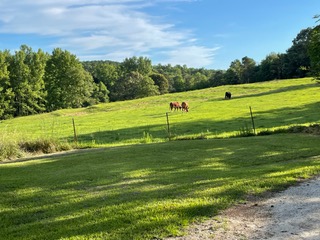Kayla Rutledge
Chapel Hill, North Carolina
June-July 2021
How is the Writing Going?
There is only one thing about Rensing I don’t like. I’m here for a few days before it happens, but when it starts, it doesn’t stop. It’s not a thing, really. It’s a question.
Someone looks up and asks, “How is the writing going?”
“Good,” I say, trying not to flinch. “Good.”
In my regular life, this is enough. “Good,” and then a change of subject. Usually, the friend or family member asking looks relieved, obliged to ask but reluctant at the prospect of an entire conversation about the artistic process (a topic that always manages to feel both intriguing and unnatural, like live TV musicals). It turns out that at Rensing, when people ask you, “How is the writing going?” they actually want to know. They are not satisfied with, “Good.”
Read other blogs if you want to know every beautiful thing about this place: that the South isn’t what you think it is, that it teems with waterfalls and copper-backed cows and people who keep their deathbed promises. The South is a silver trout wrapped in tinfoil, the smell of basil under your fingernails, beauty made with elbow grease, a row of wet white dishes on the sideboard. The one bar in Pickens County sings happy birthday to a year-old baby girl. At the flea market, I trade one of my lungs for a harmonica and a peach too soft to be cut with a knife. Did you know that fireflies come up, like worms, after rain?
For three weeks, this place and its people deliver this kind of beauty to me in abundance. In return, they ask one question: “How is the writing going?”
And for most of my time here, I don’t know how to answer.
At first, I try something vague and intellectual, like: I’m trying not to see writing as a linear process, Really, I think the idea of incremental productivity is inherently capitalistic. I’m working toward a mindset where I see every time I sit down at the desk as an integral step of the artistic journey, regardless of the output I produce for that day. (I can almost hear the asker thinking, Oh, brother.)
It’s only now, as I leave, that I realize I’ve misunderstood the question.
I remembered, recently, this quote, from the author C Pam Zhang: “When I say, I hope the writing is going well, I am saying, I hope you are able to access the truest part of yourself; I am saying, I hope you feel thrillingly alive to possibility; I am saying, I hope you feel human.”
See, I thought that “How is the writing going?” was one of those questions people ask to make sure that the world is running efficiently: What did you learn at school today? How is the weather looking? Did you finish your chores?
I still don’t know how to answer that kind of question. Mostly because I don’t like to lie, and any answer I could give would be a lie. The person I am when I’m talking to people and cooking for potlucks and hiking doesn’t write anything. Writing Me lives somewhere else, in an adjacent apartment in my brain. She does things like drive and drift off to sleep and start the kettle on the stove. She will not be dragged out by one heel to be asked if she has finished her chores.
At Rensing, I learn that there is the possibility of another, gentler kind of question, the kind we ask that mean, How are you? Questions like: Did you sleep alright? Are you feeling better? How’s your garden doing?
How is the writing going? Or, as C Pam Zhang says, “Were you able to access the truest part of yourself today?”
In my religious tradition, before we leave the sanctuary for the end of the service, the pastor offers what is called a benediction. A benediction is a blessing, a wish for protection, a bridge to join the sacred with the often scary, confusing world in which we live. Perhaps, I realize, when people ask me, “How is the writing going?” they are trying to offer a benediction. How can I fault them for that?
(When you receive a benediction, you do as I have done these past three weeks. You open your fists; you hold out your hands.)
A Benediction, for Rensings:
While you are here, and after:
May you give what you can to the work of your hands —
Your time, your worry, your tears, your friendship (which is really to say, your love.)
Refuse the first and shallow answer: “Good.”
In my tradition, they say: Remember that you are dust, and to dust you will return —
Which means, All living feels a little bit like dying
And don’t get too big of a head.
Which means, everything ends, but that’s not the same as nothing matters —
And it is not weakness to need a reminder, every so often, of the order of things.
Remember the part of you that creates is a friend, and not a mad woman in the attic,
The bridge between the sacred and ordinary
Stretches between Ellen and Evelyn’s porches. It sounds like: I care about you.
Above all, may you have “courage, and gaiety, and the quiet mind.”
Go in peace, and when you return, ask one another:
How is the sculpting, the quilting, the drawing, the music, the photography, the writing, going?



















